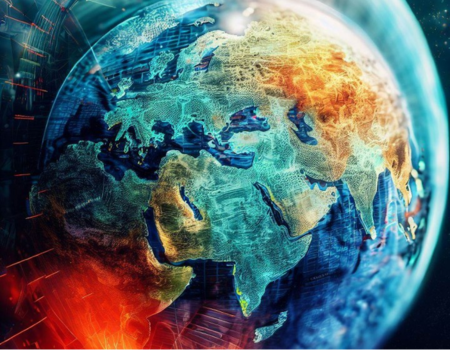Context-
In escalating geopolitical tensions and uncertainties in the maritime domain, the Yemen conflict has dealt a blow to the shipping industry's confidence in the Suez Canal as the stalwart of east-west trade routes. This has reignited discussions surrounding the India-Middle East-Europe Economic Corridor (IMEC), a concept that could provide a viable alternative.
What is India-Middle East-Europe Economic Corridor (IMEC) ?
The India-Middle East-Europe Economic Corridor (IMEC) is designed with the primary aim of boosting economic growth by enhancing connectivity and fostering economic integration between Asia, the Arabian Gulf, and Europe. It places a strong emphasis on strengthening manufacturing, ensuring food security, and optimizing supply chains.
IMEC comprises two distinct corridors:
● The Eastern Corridor: This segment establishes a connection between India and the Arabian Gulf. It encompasses a network of railroads, ship-to-rail links, and road transport routes.
● The Northern Corridor: This corridor links the Gulf region to Europe, incorporating similar transportation infrastructure such as rail, ship-to-rail connections, and road networks.
The Yemen Conflict and the Suez Canal Dilemma
The Yemen conflict has triggered a reevaluation of the reliance on the Suez Canal, prompting shippers to consider longer routes circumventing Africa. If the Yemen conflict subsides, the need for alternatives to the Suez Canal has become more apparent. The India-Middle East-Europe Economic Corridor emerges as a potential solution, gaining momentum as the shipping industry seeks reliable and secure trade routes.
IMEC's Ambitious Route: Al Haditha to Haifa
At the core of IMEC lies the ambitious plan to connect Al Haditha in Saudi Arabia to Haifa in Israel, a project that faces significant challenges. Critics argue that the Arab Street's resistance to a major trade link between Saudi Arabia and Israel, particularly in the aftermath of the Gaza war, poses a formidable obstacle. Despite a memorandum of understanding signed for IMEC, the Gaza war has delayed stakeholder meetings, hindering the progress of the ambitious project.
Geopolitical Hurdles and a Changing West Asia
Geopolitical complexities in the aftermath of the Gaza war present a substantial hurdle for IMEC. Turkey, excluded from IMEC, has expressed dissatisfaction and proposed an alternative route through Iraq to access the Mediterranean. Experts remain optimistic that Turkey could eventually be brought into the project, emphasizing the long-term trend of increased trade and strategic links between Israel and Arab nations fostered by the Abraham Accords.
The Trump Factor and China's Skepticism
The potential political resurgence of Donald Trump introduces uncertainties for IMEC. While the project aligns with a business-focused Trump, questions arise about his commitment and interest in a global initiative, raising doubts about U.S. dedication to IMEC. China's skepticism about the U.S. commitment further complicates the corridor's geopolitical landscape.
IMEC's Multi-Faceted Role
Beyond trade, IMEC envisions transporting electricity, digital cables, and hydrogen pipelines. As the world moves towards decarbonization, the corridor could be pivotal in facilitating the transition to a hydrogen economy. Hydrogen from fossil fuels, a transitional fuel until greener processes are practical, could sustain Gulf nations' involvement in the hydrogen market.
For India, containerization through rail and road in IMEC offers significant advantages. With 70% of containers in India currently transported by road, IMEC provides an opportunity to optimize the distribution with a balanced mix of road and rail, reducing port costs and aligning with India's National Logistics Policy goal of lowering logistics costs to global levels by 2030.
Optimizing Container Movement in Southern India
While IMEC's dedicated rail freight corridors link to ports such as Mundra and Jawaharlal Nehru Port Trust (JNPT), the southern region of India remains a key consideration. Experts highlight the importance of integrating southern India into the IMEC network. Leveraging dedicated freight corridors in the south could significantly reduce delivery schedules, contributing to the overall efficiency of the corridor.
Debottlenecking Haifa and Capacity Expansion
IMEC faces a critical challenge in making Haifa a substantial gateway for India to the West. Currently, Haifa's container traffic pales in comparison to Mundra and JNPT. Collaboration with Adani Ports, which has a stake in both Haifa and Mundra, could facilitate synchronized planning for capacity expansion. Drawing parallels with the United States International Development Finance Corporation funding for the Colombo deepwater container terminal owned by Adani Ports, Haifa's development could follow a similar template.
Financial Partnerships: U.S., European, Saudi, and Indian Involvement
Leading the Chinese development finance program for the Belt & Road Initiative anticipates a collaborative effort involving U.S., European, Saudi, and Indian financing for IMEC. The successful funding model for the Colombo terminal could serve as a template for Haifa's development. This multilateral approach underscores the international significance of IMEC and the diverse interests invested in its success.
Conclusion:
As global geopolitics undergo significant shifts, the India-Middle East-Europe Economic Corridor emerges as a potential game-changer in reshaping trade routes and strategic alliances. The challenges presented by the Yemen conflict, the Gaza war, and evolving geopolitical dynamics underscore the complexities facing IMEC. However, with strategic planning, international collaboration, and adaptation to changing circumstances, IMEC could navigate these challenges and become a transformative force in the future of global trade. The resilience and adaptability of this corridor will ultimately determine its success in a world marked by uncertainty and geopolitical flux.
|
Probable Questions for UPSC Mains Exam-
|
Source- The Hindu







